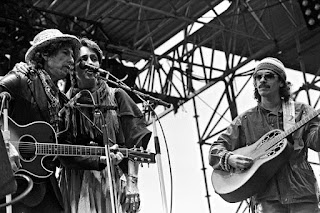Un poco de los primeros años de Carlos Santana y su iniciación como banda de rock. “Estuvo
influenciado por Ritchie Valens pero
también por los ritmos afro-americanos y de jazz latinos”. En el video comenta
sobre la música y la influencia sobre la gente. Para saber un poco más algo de Bill Graham y Fillmore West y en vocabulario: busking.
¡Damas y caballeros… Santana!
Carlos Santana (born 1947) is a Mexican and American musician who
first became famous in the late 1960s and early 1970s with his band, Santana, which pioneered a fusion of rock and Latin American jazz. The band's
sound featured his melodic, blues-based guitar lines set against Latin and
African rhythms featuring percussion instruments such as timbales and congas not generally heard in rock music. Santana continued to work in these forms
over the following decades. He experienced a resurgence of popularity and
critical acclaim in the late 1990s. In 2015, Rolling Stone magazine listed Santana
at number 20 on their list of the 100 Greatest Guitarists.
Santana was
born in Autlán de Navarro, Jalisco,
Mexico. He learned to play the violin
at age five and the guitar at age eight under the tutelage of his father, a
mariachi musician. His younger brother, Jorge Santana, would also become a
professional guitarist. Young Carlos
was heavily influenced by Ritchie Valens
at a time when there were very few Mexicans in American rock and pop music. The
family moved from Autlán de Navarro to Tijuana,
the city on Mexico's border with California,
and then San Francisco. Carlos stayed in Tijuana but later
joined his family in San Francisco. During his early years from the age of
10–12 he was sexually molested by an American man who brought him across the
border.
 |
| Bob Dylan, Joan Baex, Carlos Santana, 1984 |
Living in the
Mission District, and eventually graduating from James Lick Middle School, and
in 1965 from Mission High School. Carlos
was accepted at California State University, Northridge, and Humboldt State
University, but chose not to attend college.
Santana was influenced by popular artists of the 1950s such as B.B. King,
T-Bone Walker, Javier Batiz, and John Lee
Hooker. Soon after he began playing guitar, he joined local bands along the
"Tijuana Strip" where he was able to begin adding his own unique
touch to '50s Rock 'n' Roll. He was also introduced to a variety of new musical
influences, including jazz and folk music, and witnessed the growing hippie
movement centered in San Francisco in the 1960s. After several years spent
working as a dishwasher in a diner and busking
(playing music in a public place) for spare change, Santana decided to become a full-time musician. In 1966 he gained
prominence due to a series of accidental events, all happening on the same day.
Santana was a frequent spectator at Bill
Graham's Fillmore West. During a Sunday matinee show, Paul Butterfield was slated to perform
there but was unable to do so as a result of being intoxicated. Graham assembled an impromptu band of
musicians he knew primarily through his connections with Butterfield's band and
with the Grateful Dead and Jefferson
Airplane, but he had not yet chosen all the guitarists. Santana's manager, Stan Marcum, immediately suggested to Graham that Santana join the impromptu band and Graham agreed. During the jam session, Santana's guitar playing and solo gained the notice of both the
audience and Graham.During the same
year, Santana formed the Santana Blues Band, with fellow street
musicians David Brown (bass guitar), Marcus Malone (percussion) and Gregg Rolie (lead vocals, Hammond Organ
B3). He was later signed to Columbia
where his band name, "Santana Blues
Band" was shortened to, "Santana"
that released a series of hit albums with an Afro-Cuban and Latin Rock feel
thanks to Carlos' exquisite guitar
playing, characterized by the self-sustaining melody that became his trademark.
With their
highly original blend of Latin-infused rock, jazz, blues, salsa and African
rhythms, the band (which quickly adopted their frontman's name, Santana) gained
an immediate following on the San Francisco club circuit. The band's early
success, capped off by a memorable performance at Woodstock in 1969, led to him signing a recording contract with Columbia Records.
Bill Graham, a Latin Music aficionado, had been a fan of the band
from its inception, and arranged for them to appear at the Woodstock
Music and Art Festival before their debut album was even
released. They were one of the surprises of the festival; their set was
legendary and later the exposure of their eleven-minute instrumental "Soul Sacrifice" in the
Woodstock film and soundtrack album vastly increased their popularity.
Santana´s songs at Woodstock
included:
Waiting
You Just Don´t Care
Savor
Jingo
Persuasion
Soul Sacrifice
Fried Neckbones
Carlos Santana Best interview ever 1971 (1.11)
Esta es una entrevista muy corta. Mientras come
Santana habla sobre la música, lo que le hace a la gente. Es como que no
esperara la nota, que alguien estuviera allí.
— ¿Cómo empezaste tu grupo y cómo te iniciaste en la
música?
—Solo por ver lo que le hace a la gente. Lo que le
hace al medio ambiente. Al momento en que la música está en el aire ves a la
gente cambiar, the mood, la forma en que habla, todo el ambiente se hace más
natural, la gente es más como ellos.
— ¿Sientes que estás liderando un grupo de rock?
—No, no siento que estoy liderando un grupo de rock.
No los puedes poner en una bolsa.
—Ellos tienen toda clase de ritmos y toda clase de
sentimientos.
Para saber
The
Fillmore West fue un lugar histórico de música rock and roll en San Francisco, California, que se hizo famoso bajo la dirección
del promotor Bill Graham desde 1968
hasta 1971.
Artículos
relacionados
Fuentes
Santana, Wikipedia
No comments:
Post a Comment